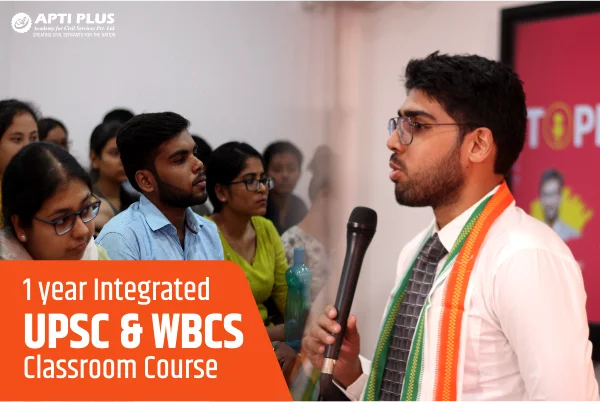Apti Plus - We Offer the Best Services to Make Cracking UPSC Easier for You!
The UPSC exam, conducted by the Union Public Service Commission, opens doors to prestigious civil service roles in India. The syllabus may seem overwhelming, but that’s where Apti Plus comes in! We aim to empower you with effective strategies, valuable resources, and personalized guidance to tackle all aspects of the exam. Cracking the UPSC exam goes beyond just knowing the content. It requires mastering time management, sharpening analytical skills, and staying updated with current affairs. And the journey starts with being aware of the UPSC exam pattern.
Read on to learn everything about the UPSC CSE exam pattern, and download the UPSC exam pattern PDF.

UPSC Exam Pattern
As explained above, the UPSC civil services exam has a fixed pattern that candidates must follow. The exam has two main stages known as the Prelims and Mains respectively. However, there is also a third stage that candidates need to clear so that their name appears in the final merit list. The third stage is the UPSC Interview.
Candidates who successfully clear the Prelims are eligible to proceed to the Mains. Those who pass the Main Examination then move on to the interview stage.
Stage 1: UPSC Prelims Exam Pattern
| Paper | Type | Number of Questions | UPSC Total Marks | Duration | Negative Marks |
|---|---|---|---|---|---|
| General Studies Paper I | Objective | 100 | 200 | 2 hours | Present |
| General Studies Paper II | Objective | 80 | 200 | 2 hours | Present |
Stage 2: UPSC Mains Exam Pattern
The UPSC Main exam has nine papers and is conducted in five to seven days. However, you can only take these papers if your marks obtained are above the cut-off mark in General Studies I. You also need to secure at least 33% in General Studies II in the Prelims stage.
Now, let’s talk about the Mains exam pattern. All of the papers are made up of descriptive answer-type questions. And guess what? Your performance in these papers can directly impact your final scores. So, make sure you give it your all and give it your best shot!
Now, let’s have a look at the UPSC Mains exam patterns:
| Paper | Subject | Duration | Total Marks |
|---|---|---|---|
| Paper A | Compulsory Indian language | 3 hours | 300 |
| Paper B | English | 3 hours | 300 |
| Paper I | Essay Paper | 3 hours | 250 |
| Paper II | General Studies I | 3 hours | 250 |
| Paper III | General Studies II | 3 hours | 250 |
| Paper IV | General Studies III | 3 hours | 250 |
| Paper V | General Studies IV | 3 hours | 250 |
| Paper VI | Optional Paper I | 3 hours | 250 |
| Paper VII | Optional Paper II | 3 hours | 250 |
Key Insights:
- Most papers (except for language papers A and B) follow a merit-based system. In order for your marks from Paper I to Paper VII to be considered for merit ranking, you need to score at least 25% in each language paper (A and B).
- The Language Papers A and B are important for qualification purposes. In order to pass, candidates must achieve a minimum score of 25% in each of these papers.
- It is worth noting that Paper A is not mandatory for candidates hailing from specific states (Arunachal Pradesh, Manipur, Meghalaya, Mizoram, Nagaland, and Sikkim) and individuals with hearing impairments. This exception is granted if they can provide proof of exemption from 2nd or 3rd language courses, as recognized by their respective boards or universities. The Indian Language paper covers the languages listed in the 8th Schedule of the Constitution.
So, there you go! That was all about the UPSC exam pattern and syllabus.
Frequently Asked Questions
1. What Do General Studies Papers I and II cover in UPSC Mains?
General Studies I covers Indian Heritage and Culture, delving into the rich tapestry of our nation’s history and traditions. It also explores the History and Geography of the World, providing insights into global perspectives. Society and Social Justice are key components, shedding light on societal structures and equity issues. Make sure to study topics like the Indian National Movement, lives and teachings of great leaders reformers and administrators, etc.
General Studies II focuses on Governance, Constitution, and Polity. Here, you must study the governing frameworks and understand the constitutional principles that shape our nation’s governance and policies.
2. What is paper 3 in UPSC?
General Studies III is a tech-savvy paper encompassing Technology, Economic Development, Bio-diversity, and Environment. It’s a blend of innovation, processes and the development, sustainable growth, and understanding the delicate balance of nature. You must also study topics like security and disaster management.
3. What is General Studies Paper 4?
General Studies IV revolves around Ethics Integrity and Aptitude and the principles that guide decision-making in both personal and professional spheres. You can also study case studies and the role of NGOs SHGs.
4. What are the total marks for UPSC CSE Mains?
The total marks considered for merit declaration in the UPSC CSE mains examination are 1750. Additionally, a maximum of 275 marks can be added after the Personality Test.




